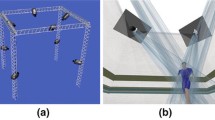Abstract
I deseribe a system that first segments an image into parts, and then fits deformable models to range data associated with the image. Models are represented by using modal dynamics applied to volumetric primitives, which significantly improves the computational complexity of both model recovery and subsequent processing. The segmentation procedure uses two simple mechanisms: a filtering operation to produce a large set of potential object parts, followed by a quadratic integer optimization that searches among these part hypotheses to produce a maximum-likelihood estimate of the image's part structure. Once a segmentation has been produced, a volumetric description is obtained by a fitting procedure that minimizes squared error between the range measurements an the model's visible surface. For simple part shapes, it is possible to compute the deformable model's parameters using only the shape of its symmetry axes.
Similar content being viewed by others
Explore related subjects
Discover the latest articles, news and stories from top researchers in related subjects.References
T.O. Binford, “Visual perception by computer,” Proc. IEEE Conf. Systems and Control, Miami, December, 1971.
G.J. Agin and T.O. Binford, “Computer descriptions of curved objects,” IEEE Tran. PAMI C 25 (4):439–449, 1976
R. Nevatia and T.O. Binford, “Description and recognition of curved objects,” Artificial Intelligence 8 (1):77–98, 1977.
D. Marr and K. Nishihara, “Representation and recognition of the spatial organization of three-dimensional shapes,” Proc. Roy. Soc.—London B, 200:269–294, 1978.
D. Ballard, “Reference frames for active vision,” Proc. Ilth Intern. Joint Conf. Artificial Intelligence, pp. 1635–1641, Detroit, August 20–25, 1989.
I. Beiderman, “Human image understanding: Recent research and a theory,” Comp. Vision, Graphics and Image Process. 32:29–73, 1985.
Jan J. Konderink and Andrea J.van Doorn, “The shape of smooth objects and the way contours end,” Perception 11:129–137, 1982.
Jan J. Konderink and Andrea J.van Doorn, “The internal representation of solid shape with respect to vision,” Biological Cybernetics 32:211–216, 1979.
D. Hoffman and W. Richards, “Parts of recognition.” In From Pixels to Predicates, A. Pentland (ed.), Ablex Publishing: Norwood, N.J., 1985.
M. Leyton, “Perceptual organization as nested control,” Biological Cybernetics 51:141–153, 1984.
D. Terzopolis, A. Witkin, and M. Kass, “Symmetry-seeking models for 3D object reconstruction,” Proc. Ist Intern. Conf. Computer Vision, pp. 269–276, London, 1987.
R. Bajcsy and F. Solina, “Three-dimensional object representation revisited,” Ist Intern. Conf. Computer Vision, London, June 8–11, 1987.
T. Bolt and A. Gross, “Recovery of superquadrics from depth information,” Proc. AAAI Workshop on Spatial Reasoning and Multi-Sensor Fusion, pp. 128–137, October 1987.
A. Pentland, “Perceptual organization and the representation of natural form,” Artificial Intelligence, 28(2):1–38, 1986.
A. Pentland, “Recognition by parts,” Ist Intern. Conf. Computer Vision, London, June 8–11, 1987.
J. Rissanen, “Minimum-length description principle,” Encyclopedia of Statistical Sciences, vol. 5, Wiley: New York, pp. 523–527, 1983.
A. Pentland, “Fractal-based description of natural scenes,” IEEE Trans. PAMI 6(6):661–674, 1984.
M. Gardiner, “The superellipse: A curve that lies between the ellipse and the rectangle, Scientific American, September 1965.
J. Williams, “The theoretical basis of the discrete element method.” In Numerical Methods in Engineering, Theory, and Application, Balkema Publishers: rotterdam, 1987.
A. Pentland and J. Williams, “The perception of non-rigid motion: Interference of material properties and force,” Proc. Intern. Joint Conf. Artificial Intelligence, Detroit, August 20–25, 1989.
A. Pentland and J. Williams, “Good vibrations: Modal dynamics for graphies and animation,” Computer Graphics 23(3):215–222, 1989.
A. Barr, “Global and local deformations of solid primitives,” Computer Graphics 18(3):21–30, 1984.
D'Arcy Thompson, On Growth and Form, 2d ed. University Press: Cambridge, England, 1942.
A. Pentland, “A new sense for depth of field,” IEEE Trans. PAMI 9(4):523–531, 1987.
J.J. Hopfield and D.W. Tank, “neural computation of decisions in optimization problems,” Biological Cybernetics, 52: 141–152, 1985.
P.J. Burt, “Fast algorithms for estimating local image properties,” Comput. Vision, Graphics, and Image Process. 21:368–382. 1983.
A. Pentland and J. Williams, “Virtual Manufacturing,” NSF Engineering Design Res. Conf., Amherst, MA, pp. 301–316, June 11–14, 1989.
M. Bove, “Discrete fourier transform based depth-from-focus,” Proc. Opt. Soc. Am. Conf. Image Understanding and Machine Vision, pp. 115–119, N. Falmouth, MA, June 12–14, 1989.
M. Raibert, Legged Robots that Balance. M.I.T. Press: Cambridge, 1986.
R.A. Hummel and S.W. Zucker, “On the foundations of relaxation labeling processes,” IEEE Trans. PAMI 5(3):267–287, 1983.
J. Tsotsos, “A complexity level for analysis of vision,” Proc. Ist Intern. Conf. Computer Vision, London, pp. 346–355, June 8–11, 1987.
A. Pentland, “Part segmentation for object recognition,” Neural Computation, 1(1):82–91, 1989.
Y.G. Leclerc, “Constructing simple stable descriptions for image partitioning,” Intern. J. Comput. Vision. (1):73–102, 1989.
Author information
Authors and Affiliations
Rights and permissions
About this article
Cite this article
Pentland, A.P. Automatic extraction of deformable part models. Int J Comput Vision 4, 107–126 (1990). https://doi.org/10.1007/BF00127812
Issue Date:
DOI: https://doi.org/10.1007/BF00127812




